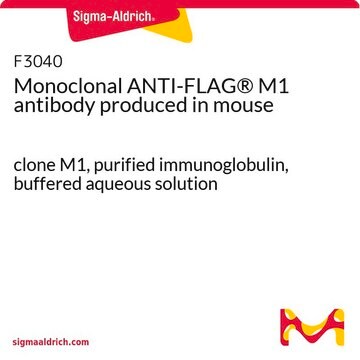F9291
Monoclonal ANTI-FLAG® BioM2 antibody produced in mouse
clone M2, purified immunoglobulin, buffered aqueous glycerol solution
Synonym(s):
Monoclonal ANTI-FLAG® M2 antibody produced in mouse, Anti-ddddk, Anti-dykddddk
About This Item
Recommended Products
biological source
mouse
conjugate
biotin conjugate
antibody form
purified immunoglobulin
antibody product type
primary antibodies
clone
M2, monoclonal
form
buffered aqueous glycerol solution
species reactivity
all
concentration
~1 mg/mL
technique(s)
dot blot: suitable (chemiluminescent detection)
isotype
IgG1
immunogen sequence
DYKDDDDK
shipped in
dry ice
storage temp.
−20°C
Looking for similar products? Visit Product Comparison Guide
Related Categories
General description
Application
Antibody is suitable for immunofluorescence, western blotting, microscopy applications and for the formation of avidin-biotin complexes.
Learn more product details in our FLAG® application portal.
Physical form
Preparation Note
Legal Information
Not finding the right product?
Try our Product Selector Tool.
Storage Class Code
10 - Combustible liquids
WGK
WGK 2
Flash Point(F)
Not applicable
Flash Point(C)
Not applicable
Certificates of Analysis (COA)
Search for Certificates of Analysis (COA) by entering the products Lot/Batch Number. Lot and Batch Numbers can be found on a product’s label following the words ‘Lot’ or ‘Batch’.
Already Own This Product?
Find documentation for the products that you have recently purchased in the Document Library.
Customers Also Viewed
Articles
Glycans play a key role in protein structure and disease; representation on cell surfaces is the glycome.
Glycans play a key role in protein structure and disease; representation on cell surfaces is the glycome.
Glycans play a key role in protein structure and disease; representation on cell surfaces is the glycome.
Glycans play a key role in protein structure and disease; representation on cell surfaces is the glycome.
Our team of scientists has experience in all areas of research including Life Science, Material Science, Chemical Synthesis, Chromatography, Analytical and many others.
Contact Technical Service















